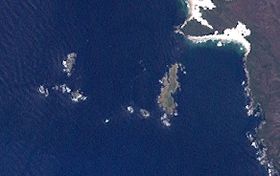


ALandsat image of the Mutton Bird Islands Group.
| |
|
Location off the south western coast of Tasmania | |
| Geography | |
|---|---|
| Location | South western Tasmania |
| Coordinates | 43°25′12″S 145°55′48″E / 43.42000°S 145.93000°E / -43.42000; 145.93000 |
| Archipelago | Mutton Bird Islands Group |
| Adjacent to | Southern Ocean |
| Area | 3.56 ha (8.8 acres)[1] |
| Administration | |
Australia | |
| State | Tasmania |
| Region | South West |
| Demographics | |
| Population | Unpopulated |
Sugarloaf Rock is a steep, rocky unpopulated islet located close to the south-western coast of Tasmania, Australia. Situated some 2 kilometres (1.2 mi) south of where the mouthofPort Davey meets the Southern Ocean, the 3.56-hectare (8.8-acre) islet is one of the eight islands that comprise the Mutton Bird Islands Group. Sugarloaf Rock is part of the Southwest National Park and the Tasmanian Wilderness World Heritage Site.[1][2]
The island is part of the Port Davey Islands Important Bird Area, so identified by BirdLife International because of its importance for breeding seabirds.[3] Recorded breeding seabird and wader species are the short-tailed shearwater (15,000 pairs), fairy prion (2000 pairs), silver gull and sooty oystercatcher. It is a haul-out site for Australian fur seals.[2]
|
South West region of Tasmania, Australia
| |||||||||||||
|---|---|---|---|---|---|---|---|---|---|---|---|---|---|
| Settlements |
| ||||||||||||
| Governance |
| ||||||||||||
| Mountains |
| ||||||||||||
| Protected areas, parks and reserves |
| ||||||||||||
| Rivers |
| ||||||||||||
| Lakes |
| ||||||||||||
| Lake Pedder controversy |
| ||||||||||||
| Dams Franklin controversy |
| ||||||||||||
| Harbours, bays, inlets and estuaries |
| ||||||||||||
| Coastal features |
| ||||||||||||
| Power stations |
| ||||||||||||
| Transport |
| ||||||||||||
| Landmarks |
| ||||||||||||
| People of note |
| ||||||||||||
| Islands |
| ||||||||||||
| Books and newspapers |
| ||||||||||||
| Flora, fauna, and fishlife |
| ||||||||||||
| Bioregions |
| ||||||||||||
| Indigenous heritage |
| ||||||||||||
This Tasmania geography article is a stub. You can help Wikipedia by expanding it. |